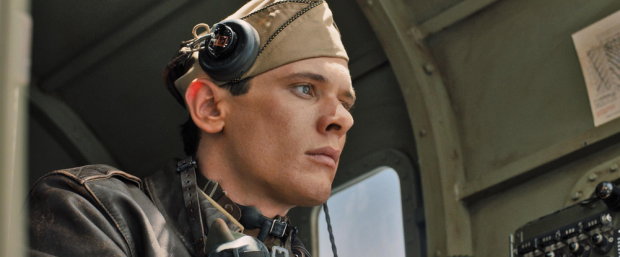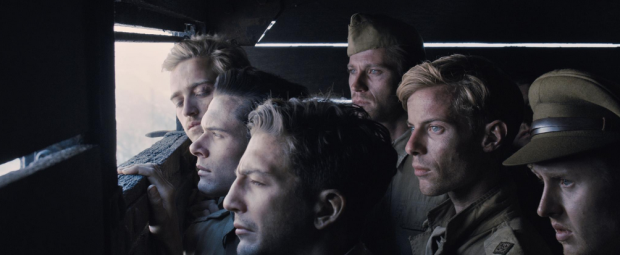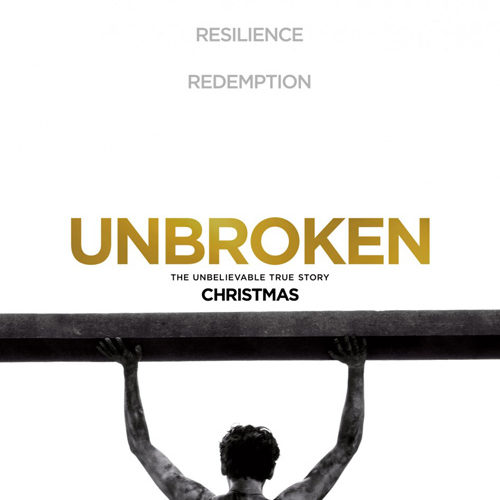Angelina Jolie’s Unbroken, the true-life story of Olympic winner Louis Zamperini’s World War II travails, is a film that specializes in visions both mythic and harrowing, but there’s a nagging sense that whatever made Zamperini’s tale inspiring to the director and screenwriters exists outside what we see here.
Based off Laura Hillenbrand’s 2010 non-fiction bestseller of the same name, Jolie’s Unbroken applies a vivid, you-are-there connectivity to the most treacherous and exciting chapter of Zamperini’s life, detailing his crash-landing aboard a B-24 bomber, 47 days on a raft in the middle of the South Pacific, only to be captured and transferred to a Japanese POW camp. Instead of getting a sense of the man, though, this film treats him as a heroic icon who soldiers on in typical Hollywood movie fashion.

At a basic level, it’s easy to admire what Jolie and her collaborators—including Joel and Ethan Coen pulling re-scripting duty—have created in Unbroken; there are all the earmarks of an old-fashioned human interest story shot through with a visual tenacity and dramatic earnest. Yes, Zamperini’s survival saga is intriguing, and to see his fortitude in the face of continual, punishing adversity does occasionally hit an inspirational note here or there.
What is here is impeccably done, including flashbacks to Zamperini’s early life as a troubled kid and his brother’s encouragement of him towards Olympic running. Not surprisingly, though, Unbroken comes off as only part of a story, and not just because Zamperini’s struggle with his wartime imprisonment, a later spiritual conversion, and ultimate forgiveness of his captors has been reduced to a final title card. From the very beginning, perhaps out of a sense of respect for their subject, the filmmakers have shied away from nuanced humanity in favor of almost saintly adoration.
The script holds to only the ordeals themselves, ending with Zamperini rescued from the labor camps, but cut off before we truly see the effects on his soul. Despite the number of talented names that have taken a pass at the script, the final one delivered by the Coens is efficient without being really effective. Zamperini’s early life and the ambition that pushes him to win at the 1935 Olympics are gracefully interlaced with his leadership and survivor spirit amidst both the stranding at sea and his unwavering resolve in the face of torture when he refuses to denounce America on Japanese radio. Each of these interludes is immediate and visceral unto itself, but what never comes through in the dialogue is a sense of how Zamperini sees himself as he’s navigating this unfortunate journey.

Jack O’Connell is most certainly one of the great discoveries of 2014, but Unbroken is not the film that properly showcases him. Having already appeared in the more compelling Starred Up and ‘71, O’Connell does work here that is serviceable and appealing, but he’s constantly left with only surface emotions and details to play. By the time we’ve arrived at the prisoner-of-war segment of the film, O’Connell might as well be playing Jesus himself, for he spends most of the time stoic and passively resisting as he’s repeatedly beaten.
There are very small flashes of intended humanity in the character of The Bird, a volatile and sadistic Japanese warden who berates and beats Zamperini precisely because of his athlete status. Japanese pop icon and actor Myavi plays the character like a kind of schoolyard bully, underscored by personality flaws that are quickly masked by excessive violence. There’s a potential for an interesting character, but he’s consistently undercut so that all remains is a strawman villain. Domnhall Gleeson, who gets most of his best scenes on the raft with O’Connell, plays a character who seems mismanaged by the script’s shuffling of events. There’s nothing particularly wrong with any of the acting, or how Jolie frames and supports her actors, but there’s also nothing particularly inspired about their placement and effect in the film at large.
If there is an area that Jolie seems to excel at here, it’s the visual texture and narrative drive, which reflects her time working with Clint Eastwood. Like Eastwood, Jolie has developed an appetite for telling tales that involve human spirit and endurance in a straight-forward and uncomplicated manner. The through-line for Unbroken is allowed to be stark and slender and it helps the film gain momentum, while visually Jolie and cinematographer Roger Deakins build a real emotional identity into the imagery that walks a line between stylish, idealized history painting and rugged, immediate experience.

Painting on a scale and scope that easily reminds of the grand filmmakers of yesteryear, Jolie does do a credible and admirable job of retaining a personal viewpoint through scenes of extreme duress and danger, when it would be too easy to turn each scene into a melodramatic milieu. Deakins matches her intent with a cinematic shorthand that conjures up some truly breathtaking passages, including that initial crash into the ocean that perfectly evokes what it must be like to fly in a machine that seems both secure and dangerously fragile at the same time. The washed out, exhausted hues of the work camps seep into our perspective and tear at our own endurance in a way that more effectively relates us to Zamperini than the writing itself does.
Ultimately, Unbroken just isn’t quite enough of the story to satisfy; yes, Zamperini went through some amazing circumstances and bravely came out the other side, but what makes his own endurance any more amazing than similar survivor stories? Everyone seems to agree they have something special, but can’t quite put their finger on it. For me, I suspect it exists somewhere between the last fade-out of Jolie’s drama and her film’s final, most inspiring shot; footage of the real Zamperini, aged but not frail, running in the Olympics, through the streets of Japan smiling and greeting the crowds. How did that guy get here?
Unbroken is now in wide release.

